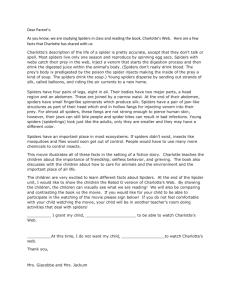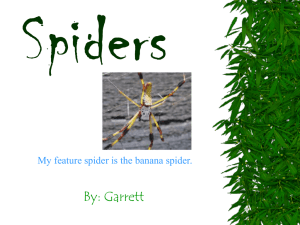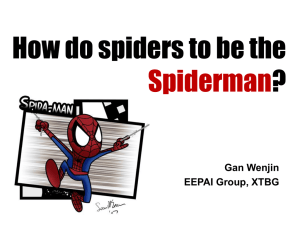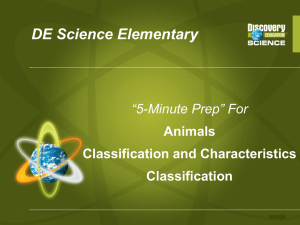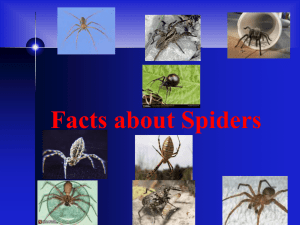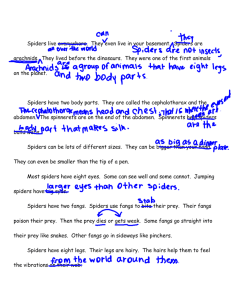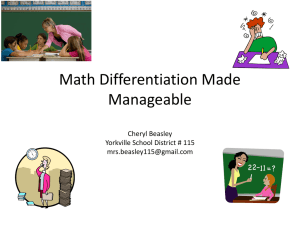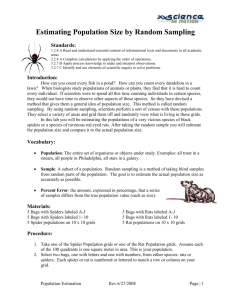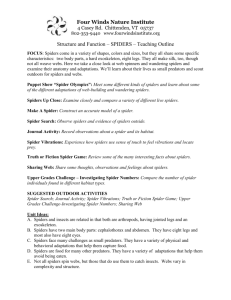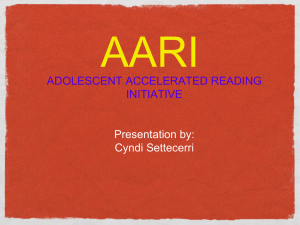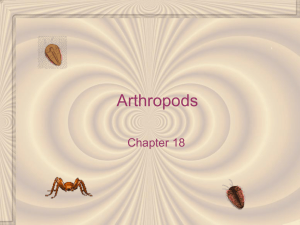File
advertisement
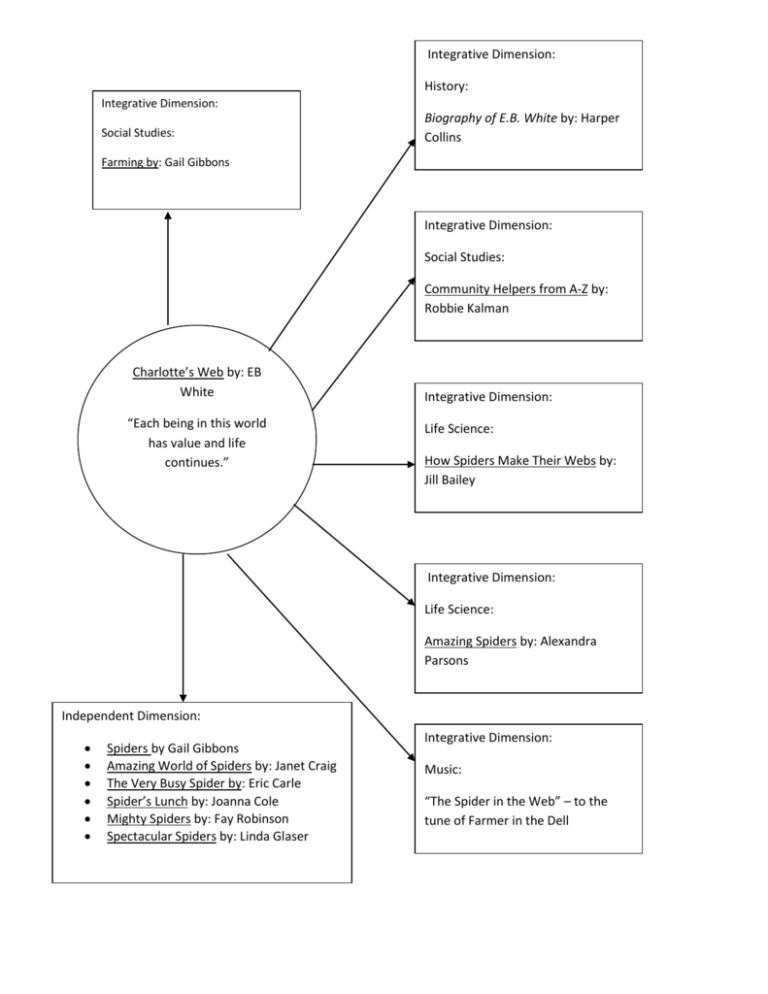
Integrative Dimension: History: Integrative Dimension: Social Studies: Biography of E.B. White by: Harper Collins Farming by: Gail Gibbons Integrative Dimension: Social Studies: Community Helpers from A-Z by: Robbie Kalman Charlotte’s Web by: EB White “Each being in this world has value and life continues.” Integrative Dimension: Life Science: How Spiders Make Their Webs by: Jill Bailey Integrative Dimension: Life Science: Amazing Spiders by: Alexandra Parsons Independent Dimension: Spiders by Gail Gibbons Amazing World of Spiders by: Janet Craig The Very Busy Spider by: Eric Carle Spider’s Lunch by: Joanna Cole Mighty Spiders by: Fay Robinson Spectacular Spiders by: Linda Glaser Integrative Dimension: Music: “The Spider in the Web” – to the tune of Farmer in the Dell GLCEs: R.CM.04.04 apply significant knowledge from grade-level science, social studies, and mathematics texts. R.NT.04.03 analyze characters’ thoughts and motivation through dialogue, various character roles, and functions including hero, anti-hero, or narrator; know first person point of view and identify conflict and resolution. W.GN.04.02 writes poetry based on reading a wide variety of grade-appropriate poetry. P2.3 Know how to find and organize information from a variety of sources, analyze, interpret, support interpretations with evidence, critically evaluate, and present the information orally and in writing, report investigation results effectively. Objectives: Students will be able to reflect on the biography of E.B. White through journal entries. Students will be able to build a character list as a class and add to it throughout the book. Students will be able to relate the characters’ feeling in the book to their own life experiences through journal entries. Students will be able to convey positive messages in one to three words. Students will be able to explain a basic understanding of how spiders make their webs. Students will be able to identify the significance of all of the creatures on the farm. Students will be able to identify the types of bugs that spiders eat. Students will be able to infer character traits from character actions. Students will be able to write poems to reflect feelings. Students will be able to use available resources to do research. Students will be able to assemble a chart of researched information. Projected Activities: Focal Dimension: Integrative Dimension: Opening Celebration: Show the cover of the Read a biography about the author, EB story to the class and have them predict White. Students will write some facts they what the story is about. found interesting about the author in a journal entry. Chapter 1 and 2 (aloud-class): Students will listen to infer character traits and the teacher will start a chart about the Teacher will read Farming by Gail Gibbons characters and will list their traits. Class will to the class and will discuss how it relates to also discuss the setting. the story. Chapter 3 and 4 (aloud-class): Students will write in their journal about a time when Students will write a poem on friendship, or they felt alone in relation to Wilbur and give describe their best friend in a poem. examples from the story why Wilbur felt Students will share poems with the class. alone. Chapter 5 and 6 (aloud-class): Charlotte will The class will add Charlotte to the character be introduced in the story and students will chart. need to look in the chapters and find words that describe Charlotte. Chapter 7 and 8 (share-pair): Students will write a journal entry about a time they Social studies- Teacher will read Community saved someone. Helpers, and class will discuss people that are important in the community. Chapter 9 and 10 (aloud-class): Class will be exploring characteristics of spiders and how Teacher will read How Spiders Make Their they spin their webs to relate to Charlotte in Webs, and students will do a worksheet the story. Class will also discuss why Wilbur about spiders with a partner. was not able to spin is own web. Chapter 11-13 (aloud-class): Students will construct their own spider webs using paint Students will sing the “Spider in the Web” and a marble and will add positive words to song. them. Students will discuss why Charlotte chose to write “Some Pig” as her first words in her web. Chapter 14 (share-pair): Students will write a journal entry about a time no one believed them, like how no one believed Fern that animals talk. Students will do a class activity, where the students will sit in a circle and throw a ball of yarn to each other and will have to say different facts about spiders. At the end, students will notice they made a spider web with the yarn. Chapter 15-17 (aloud-class): Students will Students will research fairs on the computer write a journal entry about an experience and will write down interesting facts they they had at a Fair. found. Chapter 18-20 (aloud-class): Students will Introduce, Amazing Spiders and will discuss write a journal entry about a time they felt the characteristics of spiders. Students will triumphant. create a chart about spiders, from the biggest type of spiders to the smallest. Art Project- For students to understand how Chapter 21-22 (aloud-class): Class will many baby spiders Charlotte had, students reflect about the end of the novel. Students will create baby spiders with their thumbs will also discuss their favorite parts of the using stamps. Charlotte had 514 babies and novel. the teacher will divide the number among the class so each student makes a certain number of spiders. They will each make their spiders on a big poster and reflect on it when finished. Assessment Read and check journal entries for content and relevance to assigned theme. Student work should demonstrate an ability to stay on topic and write comprehensively, using complete sentences and paragraphs. Meet with students in groups of four to share poems. Evaluate for ability to stay on topic and use of poetic elements to reflect personal feelings. Maintain a student-organized list of story characters throughout the lesson and assess character traits written by students for accuracy and level of description Evaluate positive messages written on “webs” by students for attitude and emotion. Words should convey attitudes of inspiration, motivation, self-value, appreciation, and compassion. Use unit resources to compare student explanations about how spiders make webs to facts. Keep an ongoing log of anecdotes during discussions and non-writing activities to use for assessment of student understanding of value of farm animals, inferences about character traits, and bugs that spiders eat. Track student use of library and internet resources as they are used for research; check for frequency and length of use as well as resulting information gathered by students. Keep track of students who contribute ideas and modifications to chart of big and small spiders.
